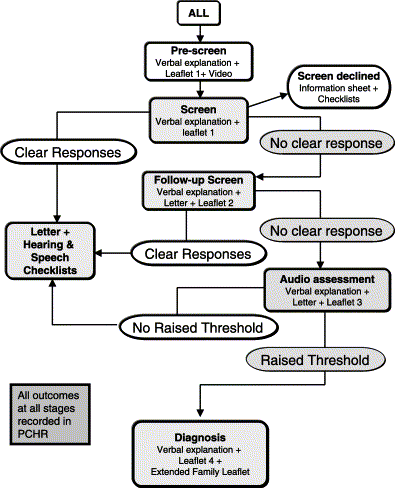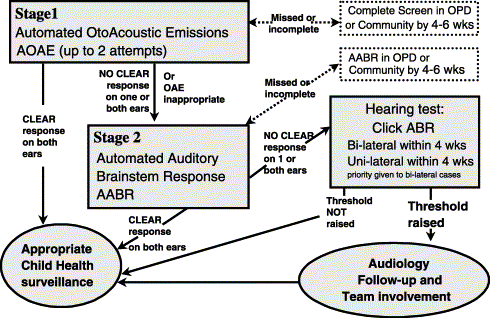Abstract
Following a systematic review of the role of neonatal hearing screening in the identification of hearing impaired and deaf children in 1997, the Department of Health in England commissioned a national programme of newborn hearing screening in 2001 and has linked a systematic evaluation to the first 22 sites in the implementation of that policy. It is anticipated that all areas of England will participate in the programme by 2004–2005. It is expected that other regions of the UK will also aim for implementation by this date.
In addition to successful advocacy by the two major consumer organisations, there were three key elements linked to the decision to implement newborn hearing screening which were primarily evidence based and also driven by two significant service developments.
The evidence base showed that newborn hearing screen was considerably more effective and efficient than the infant distraction test used in many areas and that there was a high probability that early intervention increased the potential for better language and communication.
The concern over raised anxiety for those parents whose babies need differential assessment as a result of the screen is reduced by the low number of referrals and increased efficiency of assessment when national protocols are used for screening and assessment.
The introduction of family friendly hearing services (FFHS) provides a context in which the health, education, voluntary and social services can work together to provide an equitable and seamless service throughout the year for hearing impaired and deaf children and their families.
Currently, 22 areas with 110 k births pa, have been selected for implementation, some of whom use a pilot community-based model for screening. A major barrier to rapid progress has been a lack of evidence concerning elements of the screening process, e.g. equipment, IT systems, training at all levels. It is anticipated that a further 20–40 areas with an additional 150 k birth pa will be brought into the programme by end of 2002–2003.
The aims, protocols, training programme and evaluation of the NHS Newborn Hearing Screening Programme are presented with a view to highlighting the research needed to improve specification of large scale screening programmes.
E-mail address: [email protected]
Popular choices
- Casinos Not On Gamstop
- Casinos Not On Gamstop
- UK Betting Sites
- UK Online Casinos Not On Gamstop
- UK Online Casinos Not On Gamstop
- Non Gamstop Casinos UK
- Slots Not On Gamstop
- Sites Not On Gamstop
- UK Casino Not On Gamstop
- Non Gamstop Casinos
- UK Online Casinos Not On Gamstop
- UK Online Casinos Not On Gamstop
- UK Online Casinos Not On Gamstop
- Casinos Not On Gamstop
- Top UK Slot Sites
- Casinos Not On Gamstop
- Non Gamstop Casino Sites UK
- Sites Not On Gamstop
- Casino Sites UK Not On Gamstop
- Casinos Not On Gamstop
- Casino Sites Not On Gamstop
- UK Casinos Not On Gamstop
doi:10.1016/S0531-5131(03)01026-4
Click here for the PDF version
Following a systematic review of the role of neonatal hearing screening in the identification of hearing impaired and deaf children in 1997, the Department of Health in England commissioned a national programme of newborn hearing screening in 2001, and has linked a systematic evaluation to the first 23 sites in the implementation of that policy. The programme will evolve through feedback from the evaluation team, sites and from parents. It is anticipated that all areas of England and the other regions of the UK will participate in the programme by 2004–2005.
In addition to successful advocacy by the two major consumer organisations, there were three key elements linked to the decision to implement newborn hearing screening which were primarily evidence based and also driven by two significant service developments.
Firstly, the evidence base showed that newborn hearing screen was considerably more effective and efficient than the existing universal hearing screen: the Infant Distraction Test, and that there was a high probability that early intervention increased the potential for better language and communication. Evidence for the value of early identification of hearing impairment is accruing in the USA, e.g. Refs. [1, 2]. A study conducted in the Trent Regional Health Authority UK, produced substantial data on cognitive performance of children with moderate-severe permanent hearing impairment and indicators of quality of family life (QoFL). Linear regressions controlling for potentially confounding variables, e.g. age, severity, presence of serious other disability, showed age at first fitting of hearing aids as a significant predictor of verbal and nonverbal reasoning and overall IQ, and age at diagnosis as a significant predictor of working memory, i.e. digit span. It is possible that very early cochlear implantation may lead to better outcomes too.
Secondly, the concern over raised anxiety for those parents whose babies need differential assessment as a result of the screen is reduced by the low number of referrals associated with a two-stage screen, e.g. Ref. [3] and increased efficiency of assessment when national protocols are used for screening and assessment.
Thirdly, the Trent study showed that early identification was associated with an adverse impact on QoFL in families where the services provided were perceived to be of poor quality. The introduction of family friendly hearing services (FFHS) provides a context in which the health, education, voluntary and social services can work together to provide an equitable and seamless service for hearing impaired and deaf children and their families. Hence, major innovations in services are being developed to complement the newborn hearing screening programme to promote more favourable outcomes for children identified with permanent hearing impairment. Prior to the introduction of this programme, education in England was mandated to work with over 2 year olds only, and did not provide year round cover. The Department for Education and Skills, working with the Royal National Institute for Deaf people, has now produced new strategies for working with the under 2 year olds, and to provide year round cover. Other initiatives include Early Excellence Centres which aim to promote multi-disciplinary input to assessment and habilitation.
To ensure an equitable service, national protocols have been developed, and supporting parent information (written leaflets, video, verbal dialogue) produced with the help of appropriate professionals and parents. Fig. 1 provides a flowchart of the parent information pathway. The main model of delivery is hospital based and uses a two-stage screen, i.e. TOAE followed by AABR if no clear response/s at TOAE. Fig. 2 shows the protocol flowchart for 'well' babies. Babies who are in neonatal intensive care for more than 48 h have BOTH screens irrespective of outcome of TOAE. Where possible, all babies are screened at the bedside in the presence of the mother.
The mission statement of the NHS Newborn Hearing Screening Programme also has three main elements:
- To enable high quality parent–child interaction in the first months of life for all children,
- To empower parents of hearing impaired children concerning communication options,
- To put in place an evaluative culture of service provision.
The major aims of the programme are:
- To identify 90% of children with bilateral moderate to profound permanent childhood hearing impairment within 8 weeks of age and 100% by 24 weeks of age,
- To begin an agreed habiliative programme with the family and child as soon as possible following confirmation of permanent hearing impairment,
- To enable follow up of those children with unilateral or mild hearing impairment and those at high risk of progressive impairments at an appropriate age.
Currently, 23 areas with 110 k births pa, have been selected for implementation; 4 of which use a pilot community-based model for screening. The community based model follows the same basic two-stage screen but the first screen is conducted in the community within the first 24 days of age, and in some areas the second screen is conducted in the audiology clinic.
Implementing a national screening programme has not been without its problems. A major barrier to rapid progress has been a lack of evidence concerning elements of the screening process, e.g. equipment, IT systems, training at all levels. These problems are now largely being overcome, and it is anticipated that a further 20–40 areas with an additional 150 k birth pa will be brought into the programme by the end of 2002–2003.
The aims, protocols, training programme and evaluation of the NHS Newborn Hearing Screening Programme serve to highlight research needed to improve specification of large scale screening programmes. Research teams will need to work in collaboration with other international screening teams, ORL and Audiology to explore outcomes and impact of different interventions.



